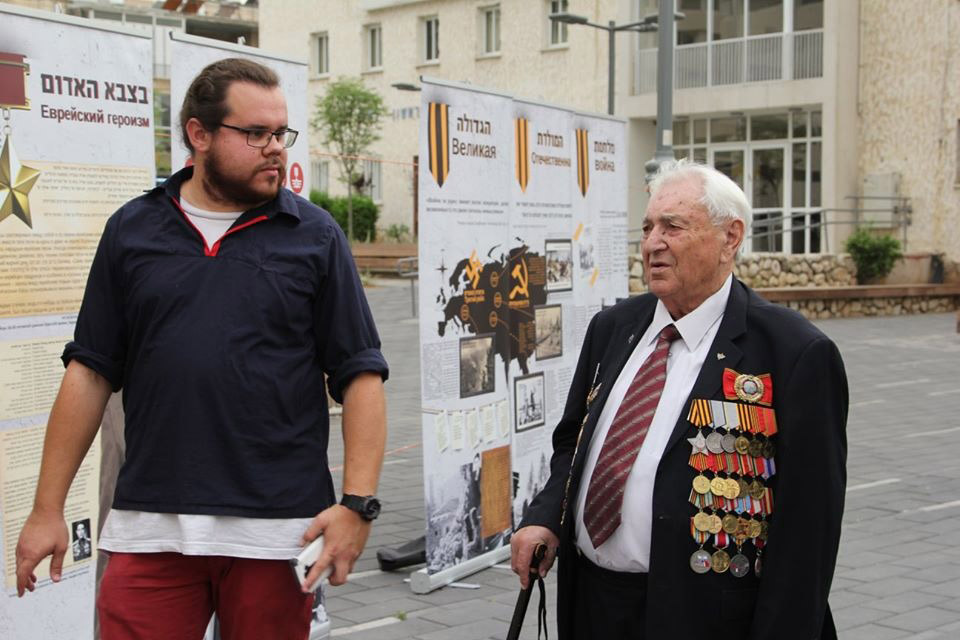
May 9 is Victory Day, a holiday that marks the surrender of German troops in 1945 to the Red Army. Originally a Soviet holiday, Victory Day became a national holiday in Israel in 2017, following a demand for recognition by olim from former Soviet Union countries.
Israel is home to a large percentage of the surviving Jewish veterans of the Red Army, since hundreds of thousands of Russian speaking Jews immigrated to Israel after the fall of the Soviet Union in the 1990s. Victory Day is celebrated in Israel with marches and ceremonies, organized by 52 veterans clubs across the country.
The population of living veterans is shrinking, however, as the remaining veterans age. Young men and women who enlisted in the Red Army in 1945 at the age of 15 to fight in the last months of the war are now celebrating their 90th birthdays.
“This year, there are almost no veterans left in the municipal clubs. They have been replaced by the second generation,” Avraham Greenzaid, chairman of the Veterans Alliance in Israel, who recently celebrated his 94th birthday, told Davar at a ceremony in Rehovot last year.
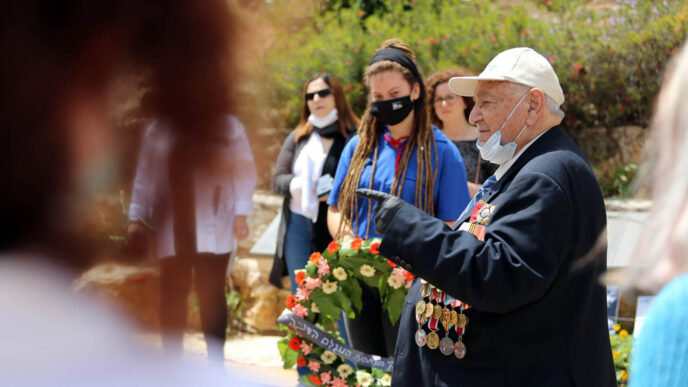
A recent connection to one’s roots and to the past
Greenzaid continues to organize veterans and keep in touch with veteran clubs around the world, but his work has focused in recent years on educating the younger generation.
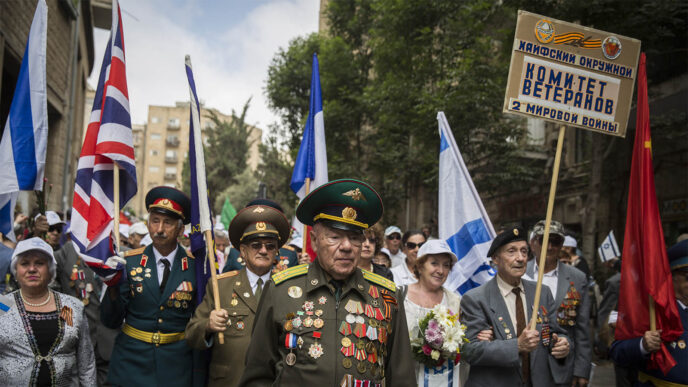
One of his “trainees” is Ilya Meinschluss (30), an educational coordinator at the Dror Israel movement, who in recent years, has created an exhibition that tells the story of the heroism of Jewish soldiers in the Red Army.
Meinschluss, a resident of Mitzpe Ramon, is a native of St. Petersburg (formerly Leningrad), a grandson and great-grandson of a veteran who immigrated to Israel with his family when he was 7, directly to Be'er Sheva.
“For a long time I did not understand the unique story of the Jews who served in the Red Army,” he said.
“Like any citizen of the Soviet Union, whether Ukrainian, Kazakh or Georgian, the Jews were called to serve their homeland,” he continued. “Antisemitism was present on the warfront and at home, and the Holocaust was in the background of everything. There is a story here that we do not talk about enough in Israel, and it is worth telling."
One of Meinschluss’s great-grandfathers survived the siege of Leningrad as a child, along with his mother. Another great-grandfather fell in battle in Ukraine. Yet another, who had reached the rank of senior officer, liberated Bulgaria and Hungary, and continued with his soldiers as far as Germany.
Meinschluss’s family connection to the story of the half million Jews who fought the Nazis — half of whom died — is extensive. Yet Meinschluss wasn’t always interested in preserving this history.
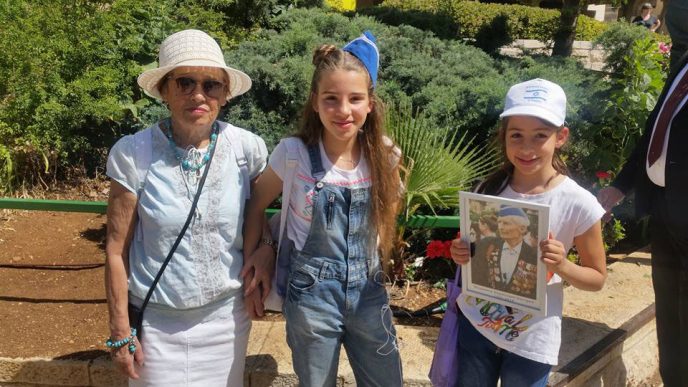
"I was a combat soldier and commander during my service in the IDF, but it was completely detached from my family heritage,” he said. “Growing up, I felt that everything that happened in Russia was not related to me. I had memories of my great-grandfather walking around with medals. He died when I was little. But, like many things that were identified with my Russian identity, like my family’s accent and manners, I preferred to put it behind me.”
"I remember the moment my perspective changed,” he said. “I was asked to run an educational program about the assassination of Yizchak Rabin and the state of Israeli democracy. The program was for immigrant youth. I sat all night and translated concepts from Hebrew to Russian. The training itself was terrible, I stuttered the whole time and forgot words, but after that I realized that the Russian language is an asset I have. It's not something to be ashamed of."
These days, Meinschluss makes sure to attend the Victory Day parades every year. He meets frequently with veterans, and organizes educational encounters between veterans and youth, soldiers, and police officers.
The Jewish motive
About 3 million Jews lived in the Soviet Union in 1939, and over half a million of them, both women and men, chose to enlist in the army. These recruitment percentages are higher than those of any other ethnic group that lived in the Soviet Union at the time.
Simultaneously, Meinschluss said, Jews faced a high level of antisemitism in the Soviet Union.
“The Bolsheviks completely erased Jewish identity. Being a Jew in the Soviet Union was on the one hand the same as being an ordinary Soviet citizen like everyone else. On the other hand, Jews were denied their religious, cultural, and communal rights,” he said.
“You were not allowed to go to synagogue. There was no celebration of holidays. Hebrew was outlawed. There was no Jewish community or a place for a person to express his Judaism,” he added.
The more research he did into the stories of Russia’s Jewish veterans, the more Meinschluss began to wonder how to reconcile the Soviet Union’s antisemitism with Jews’ apparent willingness to serve the country.
“The question arose: How is it that the Jews of the Soviet Union chose to serve en masse, and to do beyond what was necessary, for a country that erased their identity and was very antisemitic, before, during and even after the war?"
“The more I delved into the letters and materials published about those soldiers, the more I began to think it was something deeper than their duty to the Soviet homeland. They saw it as an opportunity to take revenge on the Nazis, who were trying to destroy their people and in most cases murdering their families. Many of them identified very strongly with Judaism, enough to go out and fight to the point of self-sacrifice,” he said.
“We don't pay enough attention to it,” he added. “The second and third generation certainly should know more."
A shared story of Jewish heroism
By telling the story of the Jewish World War II veterans who served in Russia’s army, Meinschluss hopes to make Russian and Soviet narratives more central in Israeli society.
“These veterans came here in the ‘90s en masse with their medals, with their stories of heroism and with passion, but they found that other stories of the Holocaust already occupied that space,” Meinschluss said. “There was no place for Stalingrad, the battles of Kursk, or the defense of Moscow."
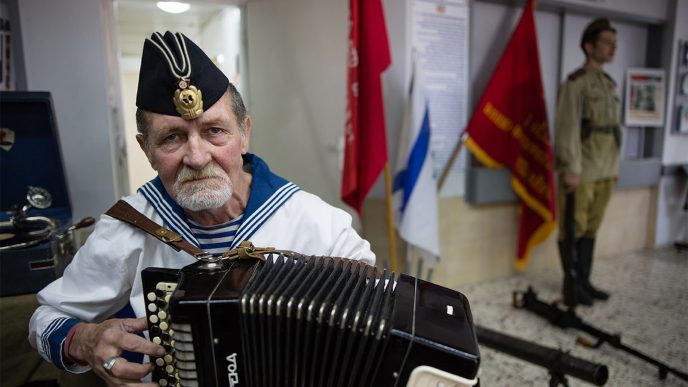
"I understand the importance of the way the story of World War II is told in Israel, but my attitude towards it is critical,” he continued. “To me, educating about the story of Jewish heroism in the Red Army is an attempt to expand the common Jewish story. Still, the heroism of Red Army veterans is considered secondary for the most part.”
On the other hand, there are examples of stories of Soviet Jewish heroism that have had a big impact on Israel’s ethos.
In 1946, a book called The Panfilov Men became a literary success in Israel. Thousands of copies were distributed to Palmach fighters as a source of inspiration. The book, written by Alexander Beck, was based on dozens of interviews that Beck conducted with Jewish soldiers on the frontlines.
A story of Jewish heroism on the Russian war front was also the inspiration for a Nathan Alterman poem called “General Hassid,” which was originally published in Davar in 1945.
"The craziest story I've heard is without a doubt the story of Yerachmiel Plzenstein,” said Meinschluss. “He was a native of Kharkov, and was educated in a Chabad cheder. This is an officer who was awarded the title of Hero of the Soviet Union, the highest decoration of World War II. He was wounded three times, very severe injuries, and each time he chose to fight again until he was told: ‘Enough, you have contributed enough.’ And after all that, in the ‘70s he fought the Soviet authorities to immigrate to Israel and was allowed to immigrate only after he handed over all his medals. In the end, he made aliyah and in the 1990s, Russia returned the medals to him.”
‘Memory affects our choices in the present and who we will be in the future’
For the past several years, Meinschluss and his partners have traveled around the country with their mobile exhibit about the history of Soviet Jewish heroism in World War II. With the exhibit as a base, they run ceremonies and memorial events throughout the year.
“Running programming for different populations made me realize that the exhibit is a good tool. It’s something that people needed, and not necessarily just people from the Soviet Union. It is a confirmation of the importance of family stories. Not many immigrant children come back from school and tell their parents that they learned about what their own grandfather did,” Meinschluss said.
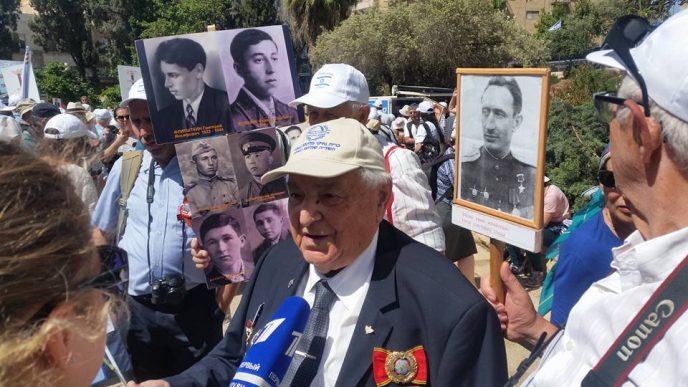
During the coronavirus lockdown, Meinschluss continued offering lectures and programs on Zoom.
“I built a presentation and a lecture for Zoom based on the exhibit. I wrote a post about the lecture on Facebook, and a lot of people responded, including teenagers, even though my lecture is intended for adults,” he said.
“So far we have worked with local municipalities, and now we are thinking of taking the exhibit to youth centers, schools, and students, and also soldiers and policemen,” he said. Meinschluss has begun planning a special training for border police and police commanders based on the exhibit.
“Everything has to be reduced, distilled,” he said of running the exhibit for wide audiences, especially youth. “The only way to do it is to turn all this material into an inspiring story, without too many academic details. There is a story about a fighter here. A Jew who continues to fight in spite of everything. For a Jewish pilot whose family was murdered by Russians in pogroms to still choose to join the Russian army to fight the Nazis — ultimately that does interest youth, because it connects them to their people’s past."
A few years ago, Avraham Greenzaid attended an event Meinschluss ran as a guest of honor, after which he wrote a letter to Meinschluss.
“He wrote to us that he did not go out to fight to defend Bolshevism or Communism. It was a war of Jews,” Meinschluss said.
“Memory affects our choices in the present and who we will be in the future,” he continued.
“The most important weapon Greenzaid tries to give to his children, grandchildren, and great-grandchildren is the understanding of what he fought for and what we need to fight for. We need to appreciate the country we have, we need to continue to create and build it, and we also need to know how to protect it,” he said.






